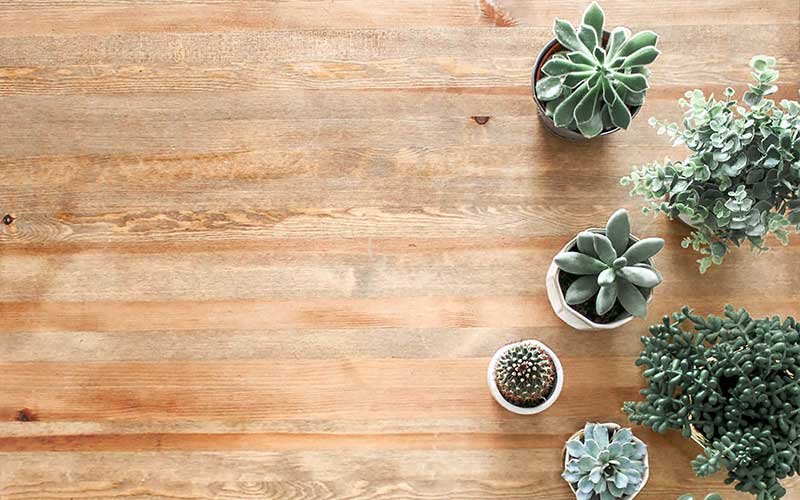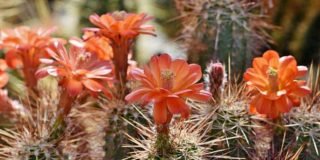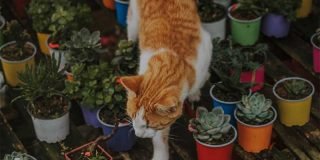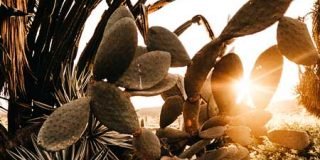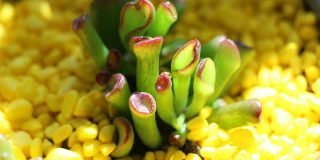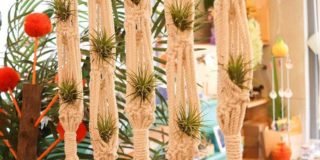Contents

If you have limited space, you can opt to hang your plants in planters or baskets. You can mix and match your succulents. You can also choose to grow your hanging succulents with other succulents that grow more erect, and the design contrast can be an excellent addition to your garden.
Hanging succulents can either be planted in-ground or in pots. In the wild, this type of plants tend to sprawl on the ground. They are often seen growing in between rocks and all-over other plants and it can be all over the place if left on its own. They can grow in every direction and will out-compete other plants in the area.
However, when planted in pots, this type of succulent can be tamed and allow their natural draping behavior to be used as an added dramatic effect on any garden or landscape. Check out the following list of the most popular hanging succulents below:
1. Rattail cactus – Its scientific name is Disocactus Flagelliformis. The rattail cactus is a native plant of Mexico. This is one of the most cultivated species of the cacti family. This succulent is a branching cactus plant that can grow up to 3 feet in length. It may be a bit similar to the peanut cactus, but it grows longer in size. Its body stores water inside so it can thrive in areas that experiences drought and harsher climates.
Its stem is covered with thin and tiny needles that give it a fuzzy look. It may be fuzzy and cute to look at, but you should always be careful when handling it as the spines can stick deep on the skin. You can place yours in a hanging container; you can appreciate its cascading beauty especially when it blooms. The rattail cactus blooms beautiful curved pink flowers which can grow up to 3 inches in length and 1 1/2 inch in width. Frequent watering is advised during its active growth period.
2. String of Pearls or String of Peas – Its scientific name is Senecio Rowleyanus. This trailing succulent is native to South Africa. This plant is one of the most popular hanging succulents because of its appearance and versatility. You can add your string of pearls on an indoor succulent garden. It will add another dimension to your succulent collection.
You can place yours on a hanging basket or small teacups. Its stems can grow up to 3 feet in length and will look amazing when left hanging on its container. You can propagate yours by using stem cuttings, it can easily grow and you can plant it in a new pot.
It looks like a small plant embedded with small pea-shaped green leaves. When growing your string of pearls outdoors, you must remember to bring them indoors during winter months because they are not frost hardy.
This succulent prefers getting a lot of bright sunlight, but you must avoid exposing them to too much sunlight as they can experience sunburn. The younger plants prefer more watering and you must water them when the soil is completely dry. It blooms white flowers with red stamens once a year during the summertime.
2. String of Pearls or String of Peas – Its scientific name is Senecio Rowleyanus. This trailing succulent is native to South Africa. This plant is one of the most popular hanging succulents because of its appearance and versatility. You can add your string of pearls on an indoor succulent garden. It will add another dimension to your succulent collection.
You can place yours on a hanging basket or small teacups. Its stems can grow up to 3 feet in length and will look amazing when left hanging on its container. You can propagate yours by using stem cuttings, it can easily grow and you can plant it in a new pot.
It looks like a small plant embedded with small pea-shaped green leaves. When growing your string of pearls outdoors, you must remember to bring them indoors during winter months because they are not frost hardy.
This succulent prefers getting a lot of bright sunlight, but you must avoid exposing them to too much sunlight as they can experience sunburn. The younger plants prefer more watering and you must water them when the soil is completely dry. It blooms white flowers with red stamens once a year during the summertime.
3. Burro’s Tail – Its scientific name is Sedum Burrito. It is a native plant found in Southern Mexico and grows up to 3.3 feet. It has blue-green fleshy leaves that are shaped like peanuts. This plant is often confused with Sedum Morganianum, as they look similar to each other. The Burro’s tail has shorter and thicker leaves. It blooms pink or red flowers during summertime. This plant prefers well-draining soil, so you must use cactus/succulent soil mixes like this.
The Burro’s Tail can tolerate dry climates but are not frost hardy, so make sure to bring them inside when you live in areas that have freezing winters. This succulent can be grown indoors and can be added to your indoor succulent garden with other small succulents and be placed in a big container. Always remember to not overwater it as it can cause its root to rot. You can place your burro’s tail in a hanging basket where it gets enough sunlight exposure.
4. Monkey’s Tail – Its scientific name is Hildewintera Colademononis. This succulent is a native plant in Bolivia. Its stems can grow up to 8.2 feet tall and it is covered with long hairy spines and its appearance resembles a monkey’s tail. It blooms red or magenta flowers that can grow up to 3 inches. This plant prefers bright sunlight, occasional watering, and must be planted in well-draining soil.
5. Calico Kitten – Its scientific name is Crassula Pellucida. This succulent is a native plant found in South Africa. It is a low-growing perennial plant that can grow up to 6 inches. You can plant this succulent on a hanging basket, xeriscapes, and rock gardens.
The leaves are fleshy and shaped like hearts. It is green with yellowish edges; some varieties have pink or magenta-colored edges. It blooms white flowers during late spring or early summer. When taking care of this plant it will require plenty of sun exposure but watch out for sunburn. You will need fast-draining soil to avoid rotting. You can use a potting mix with some sand, get yours here.
6. String of Bananas – Its scientific name is Senecio Radicans. It is also known as Banana Vine, Necklace Plant, Creeping Berry, and Fishhook Senecio. It is commonly found in Lesotho, Namibia, and South Africa.
This plant can tolerate dry climates so no need to water daily, most of the time, you can water it is during the summer when the soil dries quickly. Avoid overwatering this succulent because it can cause rotting of the roots. You must use well-draining soil when planting it. You can use pumice stones to allow for the fast-draining of water.

7. Donkey’s tail – Its scientific name is Sedum Morganianum. It is also known as Lamb’s Tail. This plant is a native to Southern Mexico and Honduras. It is related to Sedum Burrito but the foliage of both plants differs in shape. The Donkey’s tail grows longer and has flatter leaves. The leaves are pointed and slightly curled.
Its stems trail as it grows and is considered as one of the most popular hanging succulents. When treated well, the donkey’s tail can grow up to 3 feet in length. This plant has the potential to bloom flowers but it is usually rare. You must bring it outdoors so it can receive plenty of sunlight and leave it in an area with a cool temperature.
8. Peanut Cactus – Its scientific name is Echinopsis Chamaecereus. This plant is native to Argentina. It can grow up to 6 inches in length and its stems are fingerlike. It has soft spines and is generally harmless even when held.
During late spring, the peanut cactus blooms flowers that are red or red-orange and can grow up to 2 inches in width and resembles large daisies. The stem of this succulent has ridges that look like a peanut shell. Its stems have round edges.
The peanut cactus can be planted in hanging baskets so their stems can branch out freely. Use a well-draining potting mix when planting the peanut cactus. When watering, make sure that the top inch of the soil is dry. You can water frequently during summertime and you must keep it dry during the winter months.

9. Ruby Necklace – Its scientific name is Othonna Capensis. This hanging succulent is a native plant of South Africa. It is a member of the sunflower family. Its leaves are fleshy and elongated which resembles beans. The stems are purple or red and its leaves are usually green, burgundy, or purple. Make sure to plant your ruby necklace outdoors because they prefer bright sunlight and can tolerate full sun exposure.
All year round it can bloom yellow flowers that have round and elongated petals that look like daisies. During the summertime, it can grow and spread quickly. Remember to plant it in well-draining soil and water only when the soil is dry. Provide more water during summertime and less during wintertime.
10. The Hindu Rope – Its scientific name is Hoya Compacta. It is also known as Hoyas. This plant is a draping succulent vine. It has waxy flowers and leaves. Its leaves are fleshy, curly, and dark green. It blooms pale pink flowers with a white corona and red ring.
Its flowers only last for approximately one week. If you live in a tropical climate, this plant can be planted outdoors because it is drought-tolerant. It is easy to care for and you can bring it indoors, you can use grow lights like this. You must use well-draining soil and always remember to not leave this plant in moist soil as it can cause its roots to rot.
11. String of Beads – Its scientific name is Senecio Herreianus. This plant is similar to the succulent Senecio Rowleyanus. This plant is sometimes called String of Pearls. It is an extremely hardy plant, it can thrive in dry climates because the leaves store water inside and they resemble beads.
If you own this plant, they will rarely need irrigation, remember to allow the soil to dry out in between two watering sessions. This plant experiences winter dormancy. It can survive outdoors during wintertime. Don’t forget to trim the long stems during early spring before the growing season starts.
12. String of Hearts – Its scientific name is Ceropegia Linearis Woodii. It is also known as Rosary Vine. This succulent is a native plant from South Africa and has heart-shaped pale to dark green leaves. Its vines can trail and grow over 6 feet in length. The String of Hearts is related to the Hoya plant and they share the same family. You can plant your String of Hearts in a hanging basket or as a trailing plant in a container.
You can grow this plant easily; just make sure to provide bright indirect light. Water the plant when the top inch of the soil is dry. You can water it more frequently during summertime and less during wintertime. Use a well-draining soil when planting it in your garden.

13. Dragon Fruit – Its scientific name is Hylocereus undatus. Yes, you read it right! The dragon fruit is a succulent plant. It is a branching cactus that looks amazing and can be added to your succulent collection. It looks its best when grown in hanging baskets. It produces beautiful nighttime blooms and eventually edible fruit. Yum!
14. October Daphne – Its scientific name is Hylotelephium Sieboldii. The October Daphne is a succulent that grows and spreads if left alone in the wild. It grows up to 4 inches tall and 8 inches wide. A native plant from Japan, it is perfect for xeriscapes. It produces horizontal branches and it has round, fleshy, blue-green leaves. It blooms bright pink star-shaped flowers and usually forms in round clusters.
15. String of Nickels – Its scientific name is Dischidia nummularia. This succulent is a trailing plant and can be planted outdoors in your garden. It has beautiful foliage, round gray-green leaves that resemble nickels hanging from strings, hence it is called String of Nickels. This plant can be grown in a hanging basket or you can keep it in a tall pot to allow its stems dangle or cascade down beautifully.
Tips When Growing Hanging Succulents in Planters:
- Hanging plants usually need moist soil.
- When planting succulents in hanging pots, plant several of the same kind of succulent to have a full basket, you will be amazed when the basket appears to be brimming over the edges.
- When growing plants outdoors, you must water multiple times, especially during warm and windy weather. Plants usually need watering once or twice per week. Do not overwater as it can cause the roots to rot.

How to Care for Hanging Succulents
1. Succulents are normally easy to care for. Beginners who prefer to grow succulents will find it easy to do so. When taking care of succulents, make sure to avoid overwatering. Use potting mix soil that allows the fast draining of water. You must use cactus/succulent potting soil mix like this.
2. When watering the succulents, allow the soil to dry before watering them again. Choose terracotta containers as they allow the fast draining of water and you must only use containers that have drainage holes. If it does not drain water well, you can use perlite, moss, or sand in your soil mix.
3. When fertilizing the plant, you can do it every three weeks while the plant is actively growing or during summertime. Do not overdo it as it can also kill your plants. Get your fertilizer here.
4. When planting your succulent, it will need enough sunlight to live. Succulents need at least 4 to 6 hours of sunlight every day. You can grow succulents indoors just make sure to use grow lights like this.
5. When repotting the succulent be gentle and avoid too many falling leaves, especially those plants that have fleshy leaves. You can wrap the leaves with cloth or plastic before moving the plant. Be careful and gentle when holding the plant. If the soil is extremely dry, moisten it first so you will not have a hard time handling your plants while repotting it.
Hanging succulents can be planted in planters, pots, or containers and will add a dramatic effect when allowed to drape or spill over the containers. Depending on the variety of the succulent, they can grow in different sizes and trail at different rates. If you are planning to propagate them, you can do so by cutting the stems and planting them in different pots. There are soft and hardy varieties of hanging succulents that can be added to your hanging garden.
Hanging succulents can be used as lovely decorations indoors and outdoors. You can place them in hanging baskets. You can find a place for them in a vertical garden if you have one. You can also make use of a wall planter or place it on decorative pots, you have plenty of choices.

We have all sorts of information on how to grow and take care of succulents. If you have any comments, suggestions, questions, or inquiries please let us know, we would love to hear from you!
Hanging Planter Flower Plant Pots
Shop Succulents
Keter 221486 Hanging Planter Set
- 2 attractive hanging spheres make a great addition to any part of your home – indoors or outdoors
- Measures 13.9″ wide by 13.9″ deep by 15″ high

